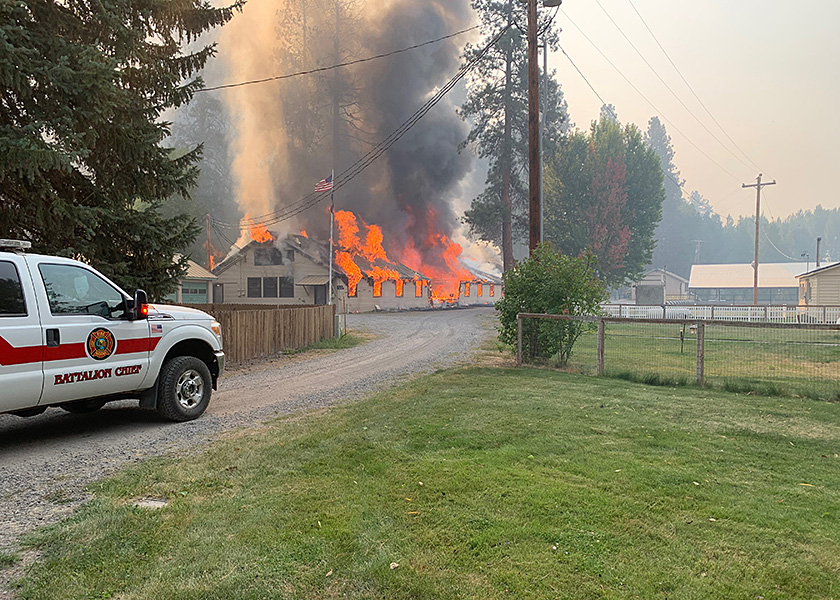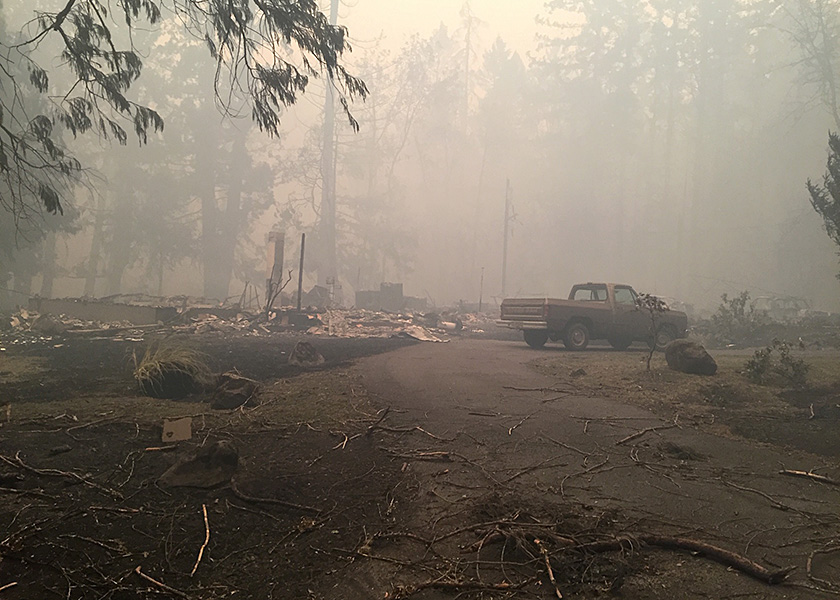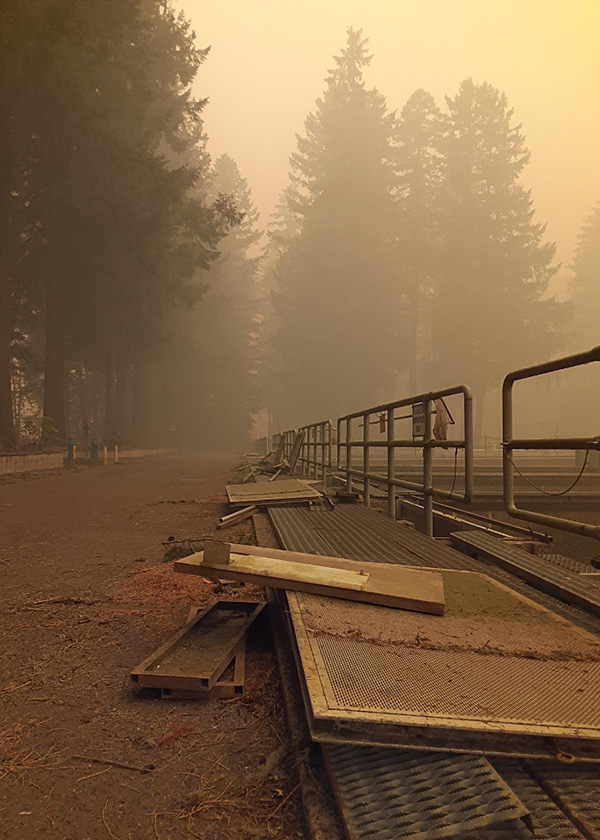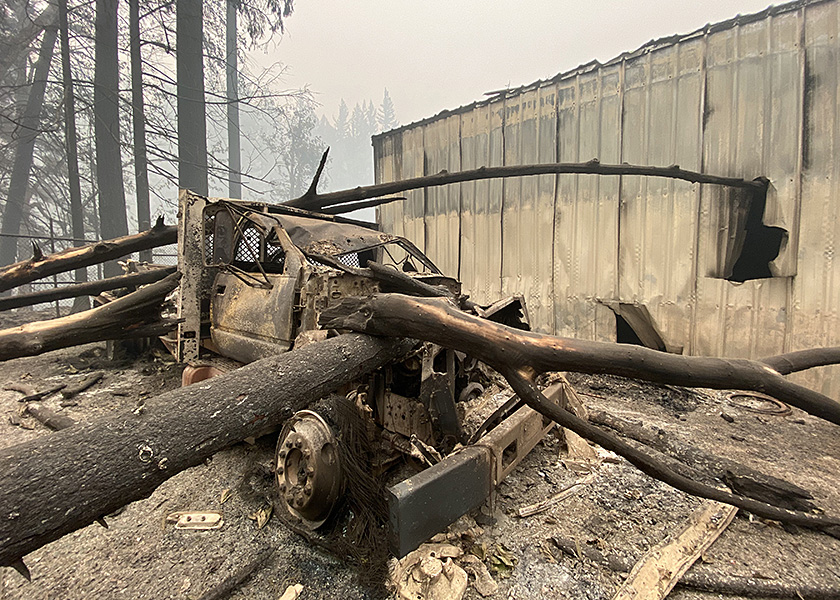
ODFW Details Impact Of Fires On Hatcheries; Rock Creek On North Umpqua Hit Hardest; Millions Of Fish ‘Remain Alive’
THE FOLLOWING IS A PRESS RELEASE FROM THE OREGON DEPARTMENT OF FISH AND WILDLIFE
Despite the unprecedented wildfires and evacuation of six ODFW-managed fish hatcheries, millions of fish at these facilities remain alive with hatchery staff returning as they are able to care for fish and even spawn spring Chinook during a critical time in their life cycle.

Most importantly, no lives were lost among ODFW hatchery staff and their families who had to evacuate. Unfortunately, some critical infrastructure and fish were lost, with Rock Creek Hatchery on the North Umpqua River sustaining the most severe damage followed by Klamath, Leaburg, and Minto.
With the permission of authorities managing fires, some ODFW staff have been returning periodically to even Level 3 evacuation areas on a limited basis to keep fish at the hatchery alive (by assuring that water is flowing, feeding fish, controlling debris, fueling generators, etc.) and to perform other critical tasks such as spawning spring Chinook.
Rock Creek sustained the most severe damage of all hatcheries. With the exception of the Rock Ed Education Center, all buildings and employee housing were either destroyed or severely damaged by the Archie Creek Fire. Staff access has been more limited than at other facilities due a number of hazards around the site including downed trees and power lines. Some hazards were eliminated to allow staff to get in today (Sept. 16), remove about 700 remaining adult spring Chinook and summer steelhead and move them to Cole Rivers Hatchery with the intent to spawn and collect enough eggs to meet Rock Creek’s production goals. Staff estimates 400,000 juvenile fish were lost and although the extent of fish loss is currently unknown, we expect to know more later this week. The site remains at Evacuation Level 3.

At Leaburg Hatchery, staff who were evacuated from the hatchery and their homes at 2 am. on Sept. 8 due to the Holiday Farm fire returned later in the morning to release approximately 1.16 million fish on site into the McKenzie River as the hatchery lost water.Eugene Water & Electric Board (EWEB) was forced to open the Leaburg Dam rollgates as a precaution as debris from the fire could come down the river and clog or overtop the dam, which dewatered Leaburg Lake and the hatchery. “Those fish would not have survived very long without new incoming fresh water,” said Erik Withalm, Leaburg hatchery manager. “We pulled tail screens to get fish out as quickly as we could before evacuating again as the fire approached. Fortunately, structures at the facility sustained only minor damage with only the wellhouse and a tractor burning.”

Most of the fish released from Leaburg (yearling spring Chinook, summer steelhead and rainbow trout) are expected to survive after spending the next few months in the river. The spring Chinook and summer steelhead that were released will then head downstream to the ocean as part of their natural life cycle with some eventually returning to the hatchery in 2-4 years. The rainbow trout will stay in the river and continue to provide a fishing opportunity for anglers. Some fish on site that were meant for release in another basin (Rock Creek spring and fall Chinook and summer steelhead) were not released and died on site as under fish management plans, ODFW hatcheries do not release “out of basin” stocks. While the vast majority of fish released made it out to the river, an estimated 5-10 percent did not get out of the hatchery before it was dewatered.
As Leaburg Lake levels have come up, hatchery staff are returning to the site as they are able to recollect spring Chinook adults in the trap for eventual spawning and to transfer any eggs to McKenzie Hatchery. Any dead fish at the site are being removed. The hatchery’s popular sturgeon also survived the fire, but may eventually be released into the McKenzie River as the hatchery is no longer suited for long-term holding of the sturgeon due to likely water supply issues that will occur in the coming months.

Minto Fish Facility’s Manager Greg Grenbemer described it as a “miracle” that all has gone so smoothly at his facility near Gates, which was evacuated due to the Beachie Greek Fire. The generator and water pumps have been running so no fish have been lost. A few staff and fish pathologists were also able to return this week during a critical time to spawn spring Chinook while their egg quality is optimal and before adults die. (Due to their natural life cycle, not the fire, spring Chinook egg quality will quickly diminish if the adults are not spawned at a certain time and the adults will die soon after, resulting in fewer smolts released from in 2022 and poor adult returns in 2024). So far since evacuation, the crew have been able to spawn an estimated 840,000 eggs from their North Santiam spring Chinook adult broodstock, and intend to spawn another 900,000 eggs in coming days. “We were able to preserve this year’s generation,” said Grenbember. “Those eggs will go to Roaring River until we can take them back to our hatcheries on the Santiam River.” (See video of fish spawning at ODFW’s YouTube page)
Marion Forks was also spared from damage, and staff are returning as they can to clean ponds and screens and feed fish to keep them alive.
At Klamath Hatchery, a hatchery building, shop and office complex were lost in the Two Four Two fire, and power, water and sewer compromised. An estimated 50,000 triploid brown trout were lost—20,000 of those meant for Diamond Lake and the rest for other locations. Staff are cleaning up and developing contingency plans for 2021 production and stocking. The Klamath Hatchery receives brown trout eggs from California Fish and Wildlife each year, and we hope Diamond Lake stocking of triploid brown trout will be able to resume as normal in 2022. (Diamond Lake is also stocked from other hatcheries so will still be stocked with rainbow and tiger trout in 2021.)
“We are still very much in the emergency response phase. The safety and security of our staff is priority one, and we have dozens of staff who have been impacted by the evacuations from their homes,” ODFW Deputy Director Shannon Hurn said. “As the state sees more stability and abatement of active fires, we will determine over the next week or two the extent of the fish loss and damage. Then, it will be time for long-term planning for repairing, replacing and funding the recovery of our infrastructure. We will also need to plan as best we can for expected mudslides or debris flows that will occur with the fall rains on burned areas, which will further complicate hatchery management.”
While they assess fish loss, Fish Division staff statewide are also developing contingency plans for production and stocking in 2021 and into the future.
Other hatcheries that were evacuated during Oregon’s unprecedented wildfires include the Clackamas Hatchery (Estacada), which is threatened by the Riverside Fire, but the fire has not reached the facility yet and so no structures are damaged. Fortunately, despite waterflow issues over the weekend, water has been restored and no fish have been lost. Staff continue to access these facilities on a limited basis to keep fish alive. Equipment has been relocated to other facilities in less fire danger. Clackamas hatchery staff also assisted in caring for fish at the Eagle Creek National Fish Hatchery over the weekend (Eagle Creek rears Clackamas spring Chinook and winter steelhead for release in the Clackamas Basin). Fortunately, no fish have been lost yet.
The Salmon River Hatchery in Otis was also evacuated due to the Echo Mountain fire and still has no power, but the generator is working and there does not appear to be fish loss. Hatchery staff continue to access the facility during the daytime to ensure fish are kept alive.
Other fish hatcheries have been at Level 1 or 2 Evacuation status in recent days including Cole Rivers, Dexter, Oak Springs, Roaring River, Sandy, South Santiam/Foster and Wizard Falls as well as the Clackamas regional office. Staff are moving equipment offsite and have developed contingency plans for fish holding or release if Evacuation Levels move to Level 3.
“On behalf of the Department I would like to say thank you to all the firefighters and those volunteer on the front lines. We are very aware that the damage at several of our hatcheries would have been much more extensive without them,” continued Hurn. “Also, I’d like to say thank you to Oregon’s law enforcement, cities, counties and other community services for the relief they are providing. It is heartening to see these small forested communities rally together in the face of such devastation.”
